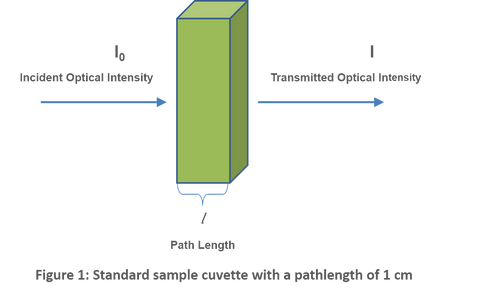Ask an Expert: What is the difference between Optical Density, Absorbance and Extinction of gold nanoparticles? How do you calculate these values?
To understand these properties, let us consider the path of light through a sample cuvette.

Optical Density
Optical Density is the optical attenuation per centimeter of material as measured using a standard spectrophotometer, typically specified with a 1 cm pathlength. Nanoparticle manufacturers often use optical density (OD) in place of mass or molar concentration because it is directly proportional to concentration and it is a more convenient way to express the amount of optical absorption taking place in the nanoparticle solution at the wavelength of interest. A product that has an OD of 100 is 100X more concentrated (Has 100 times more particles/ml) than a product that has an OD of 1. As a rule of thumb, OD = 100 gold nanoparticle solutions are used for animal injections and lower ODs of between 1 and 10 are used in cell culture experiments.
Optical density can be defined at any wavelength, but in the case of nanoparticles is typically given at the wavelength with peak absorbance. In nanorods in particular, the ratio of optical density at the longitudinal SPR to the transverse SPR is used as a measure of shape purity; the higher the ratio, the lower the percentage of unwanted shapes (spheres). Our rods have a ratios > 3.5, indicating > 95% shape purity.
Optical Density can be calculated using the formula:
In the case of homogenous colloidal solutions (such as Gold Nanoparticles), the optical density is a function of the solution’s concentration. Therefore, optical density can also be expressed as: [the molar absorbance coefficient (the absorbance of the solution per unit length per mole of solute) x the molar concentration of the solution x the pathlength of the light (typically 1 cm)]. Coupled with knowledge of the nanoparticle size, this allows for the approximation of the number of nanoparticles per mL of solution.
On our spec sheets, you will always see the number concentration of nanoparticles based on the peak optical density and mass concentration.
Optical Absorbance
The term ‘optical absorbance’ is typically used in the biology, pharmacology, and chemistry fields, and refers to the net losses, or attenuation, of light through a material. Generally, optical absorbance is the ratio (dimensionless quantity) of the amount of light absorbed by the nanoparticle solution (due to optical absorption and optical scattering) to the amount of incident light directed at the sample.
Optical Absorbance can be calculated using the formula:
When specified for a given wavelength, optical absorbance is equivalent to optical density; however, the general term typically describes the full spectra.
The optical absorbance spectra contains information on nanosphere or nanorod quality. The narrower the peak width, the smaller the standard deviation of particle diameter or aspect ratio, respectively. We provide the peak width at 80% of the maximum peak as a measure of this quality on our tech spec sheets.
Optical Extinction
Optical extinction, a term typically used by physicists and engineers, is the net loss, or attenuation, of light through a material. Like optical absorbance, optical extinction is the addition of optical absorption and optical scattering of a material.
Optical Extinction can be calculated using the formula:
The terms ‘optical absorbance’ and ‘optical extinction’ are sometimes expressed ambiguously, with optical extinction sharing the same formula as optical absorbance. The ratios and measures described for optical absorbance can be used interchangeably with optical extinction.
Other terms to know:
Absorbance Coefficient: Unlike optical absorbance, the absorbance coefficient represents the optical attenuation per unit length of material (typical units are 1/cm). This is a measure of how easily light passes through a material: higher absorbance coefficients indicate that lower amounts of incident light will pass through the material. The absorbance coefficient at a given wavelength is dependent upon the component materials, size, and shape of the nanoparticles, and is therefore requires complex modeling to match theory with reality. In practice, the absorbance coefficient for gold nanoparticles is back calculated by measuring the full absorbance spectra and correlating it to samples with known nanoparticle sizes and mass concentrations.
Extinction Coefficient: Unlike optical extinction, the extinction coefficient represents the optical attenuation per unit length of material. The dependencies and calculations described above for the absorbance coefficient are all valid for the extinction coefficient as well.
Optical Cross-Section or Attenuation Cross-Section: is the effective area that quantifies the intrinsic likelihood of an attenuation (absorption and scattering) event when struck by a photon. Rather than representing an actual area, this value represents a measure of the probability that an absorption or scattering event will take place, similar to the molar absorbance coefficient.
Please feel free to contact us if you need any additional information about any of these properties or coefficients.
Ask an Expert:
Have a question for our scientists about working with gold nanoparticles? Submit your question using this quick form.
Related links:
Plasmonic properties of gold nanorods
Ask an expert: What is the difference between citrate, CTAB, PEG & Silica coatings?





